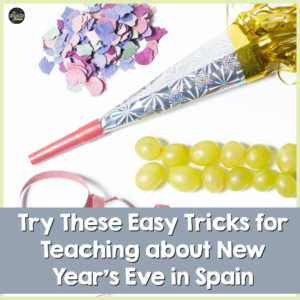Your students don’t read as much in Spanish as you would like, right? Or perhaps you’ve done a story with them but then it just fizzles and you don’t feel they got as much out of it as they should have? Why is that? Our students need to see Spanish written correctly a TON before they actually acquire it. So I started adding pre and post- reading activities to give them that increased input. Curious how I set up my 1 week lesson for short stories? Read on!
Day 1 – Vocabulary Building Activities
My students get exposure to the key vocabulary words they will see in the story through a variety of activities and games. I give them a master list of the words for reference. Some examples of vocabulary activities:
- 4 corners activity: Post 4 student responses around the room. In my lower level classes I use “Me gusta. Me gusta mucho. No me gusta. No me gusta nada.” Get an idea for class preferences by asking basic questions like “Te gusta el queso.” Students then move to the corner of the room that matches their opinion. For increased comprehension, project the sentences and add pictures.
- ¿Qué ves?: Project 4 or 5 images that relate to the story. Your students then fill out a “See, Think, Wonder” chart to make their predictions about the story
Day 2 – Pre-Reading Activities
- Matamoscas: Warm up the class with this classic game.
- Running Dictations
- Pre-Reading predictions- Based on pictures or the key vocabulary from the story, what do they predict the story will be about?
Day 3- Story time!
- Class read- (This is my favorite). Invite students to sit at the front of the room. Project the story on the overhead and read it out loud to the class. Stop periodically to check for comprehension.
- Small group read- Students sit in groups of 3 or 4. They should each take turns reading. They can switch after each sentence, paragraph, or page.
- Individual read- Especially if you’re using your short story at the end of the unit, this is a great way to assess what your students are capable of comprehending on their own.
Day 4 – Post-Reading Activities
- True/false questions
- ¿Cómo son? – Students argue if a character is “trabajador o perezoso,” for example, based on the text.
- Comprehension questions about the story
- Venn Diagram comparing characters
Day 5 – Show what you know
- Write an extra page to the story
- Create a drawing of the next thing that happens and write a description
- Graphic organizers– identify the main idea of the story and cite examples from the text
Ready to take your Spanish stories to the next level? You will be amazed how much your students retain when you add pre and post- reading activities to the lesson. Plus, you have an entire week’s worth of lessons ready to go (woo, hoo to easy lesson planning!). Looking for some ready to go short stories with a week’s worth of lessons? I have short stories on school, family, house, food, sports, daily routine, and more. Wouldn’t you love to have the next week already planned out?




No Comments